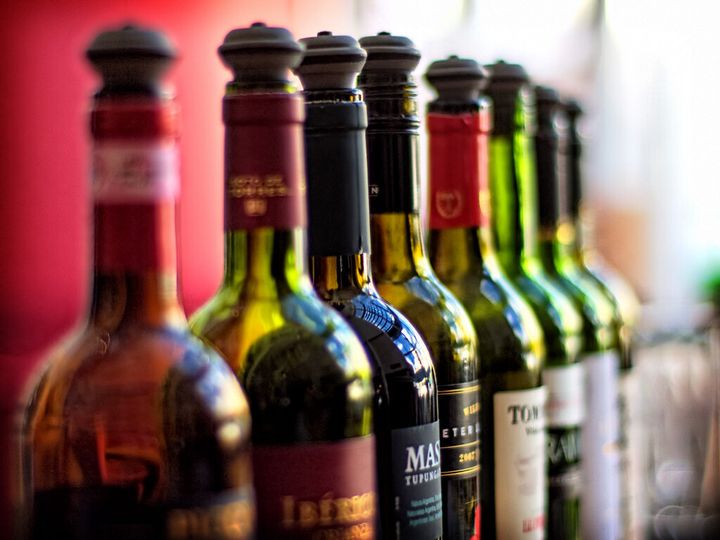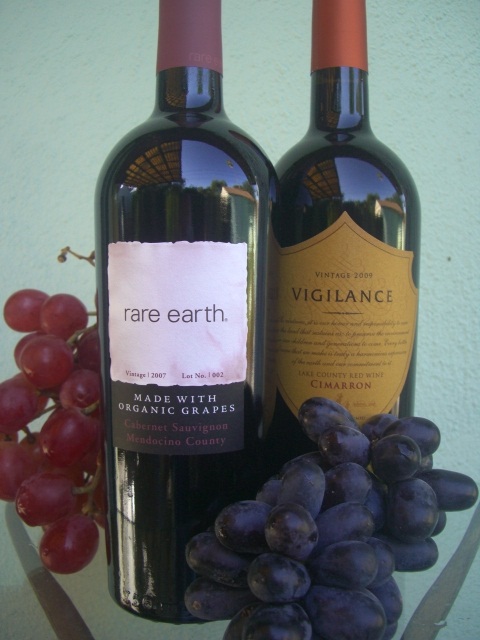

Now that the overwhelmingly gustative holiday season is nearly upon us, thoughts of turkeys and sweet potatoes and other culinary delights begin to intrude upon our everyday cogitations. Those of us who strive for a reasonable degree of environmental consciousness in our menu planning of course envision as much as possible of our feasting done in an organic mode. Surely we can extend that to the vino that graces our table as well?
"Organic" wine. A simple and desirable notion, yes? You grow some organic grapes, you turn them into wine, and voila, organic wine. Or so I thought. It turns out that environmentally responsible wine-making is considerably more complicated, and consequently controversial, than that straightforward paradigm.
There's big-O "Organic," which means one thing in the U.S. and other things in other countries -- and wine being the global affair that it is, there's your first complication. And there's small-o "organic" which is organic in practice but not officially certified. Then there's "natural," and "biodynamic," and "sustainable," each with its own rules and methods and proponents. What's an environmentally conscientious oenophile to do?
Here in the U.S., if you want to go organic, it comes down to a choice between "USDA Organic" and "made with organic grapes." The big difference? The official designation requires that there be no added sulfites in the winemaking process; and yet according to many vinicultural experts, wine without sulfites is merely fermented grape juice and will spoil quickly. And the certification process is lengthy, difficult, and expensive, which places small producers at a distinct disadvantage -- and they are the ones most likely to espouse environmentally-sound practices.
Even more difficult to locate and encourage, since there are no legally-defined designations, are the more emphatically environmental practices. "Natural" winemaking generally involves organic grapes that are processed with local wild yeasts and minimal sulfites; a sub-set of this would be "biodynamic," which has its own particular set of rules. "Sustainable" refers to the entire process of cultivation, which would begin with composting and companion planting for insect control, and sometimes proceed to providing areas for wildlife and minimizing emissions with the use of horse-drawn ploughs.
To locate these wines, you would need to research wineries and their practices, or more easily, find yourself a knowledgeable and friendly wine store clerk or two and shop with their recommendations.
But when all is said and done, the most important thing is deliciousness in the glass, right? So with a little leg-work and a lot of sampling (not such a horrifying task after all), you should be able to locate some really tasty vintages that will satisfy both your palate and your conscience.

My own recent searches led me to my favorite local BevMo store and, with the cordial help of a very well-versed associate there, a little-known family-owned winery called "Vigilance", with whom they have an exclusive relationship. These are wines that fall under the "sustainable" category, and provide a clear picture of exactly what that can involve -- the husbandry, the safeguards, and the passionate commitment required to create wines that are careful of the earth and its denizens. All that appealed to me, naturally, but "the proof is in the pudding", as my Irish grandmother used to say, or in this case, in the wine. I sampled bottles of their Petite Sirah and their "Cimarron" blend; both were awesome! I look forward to working my way through their entire line-up. Be sure to check them out in your vinous peregrinations...
Need a Little Justification? Try the "French Paradox"
For centuries, wine has been used for both medication and pleasure. But the modern world has had little use for it beyond its perceived gustatory and inebriative effects, until a series of studies in the 1980's and '90's postulated the "French Paradox" -- to wit, that the French, in spite of their high-fat and intense-dairy diet, had a much lower rate of heart disease than the Americans and British who consumed a similar diet. The dietary difference? Those little glasses of red wine that the French enjoyed with almost every meal.
The main factor in the science is thought to be the polyphenol resveratrol, which is found in the skin of the grapes; thus red wine, which remains in contact with the skins longer in the fermentation process, has a higher concentration of this useful compound. Studies have shown that it can reduce the risk of heart disease with its blood-thinning capabilities, and by lowering levels of "bad" cholesterol. There is also evidence that it helps prevent DNA mutations that may lead to cancer formation.
All things in moderation, of course; excessive amounts of any alcohol, including wine, are undesirable. But a glass or two of red wine with dinner -- why yes please!
Here are a few healthy ways to get your red wine on:
Easy Peasy Coq au Vin
2 tablespoons olive oil
4-5 pound pastured organic fryer chicken, cut into pieces
2 1/2 cups organic red wine
2 1/2 cups organic chicken broth
1/2 teaspoon garlic powder
1 teaspoon thyme
1 large bay leaf
4 strips turkey bacon, cooked & crumbled into large pieces
8-ounce bag frozen peeled organic pearl onions
8 ounces white button mushrooms, quartered
1 cup frozen organic peas, heated at last minute
In a large deep skillet just big enough to hold the chicken pieces in one layer, heat olive oil over medium-high heat; sauté chicken in oil until golden, about 4 minutes on a side. Remove chicken from pan; add wine, broth, garlic powder, thyme & bay leaf; bring to a boil. Return chicken to pan, along with bacon, onions and mushrooms. Reduce heat to medium low, cover, and simmer, turning chicken and stirring occasionally, until chicken is tender, about 1 1/2 hours.
Remove chicken to a large shallow bowl; increase heat and reduce liquid by about a third, then pour over chicken. Scatter peas across the top and serve with egg noodles or boiled new potatoes.
Serves 2-4.
Classic Mulled Wine
1 bottle robust red wine (I like Zinfandel for this)
1 cup fresh-squeezed orange juice
2 tablespoons organic honey
1 cinnamon stick
3 cloves
2 star anise
4 black peppercorns
Sprinkle of nutmeg
4 two-inch strips of orange zest
Double thickness piece of cheesecloth, @ 7 inches on a side
Combine wine, orange juice and honey in a large pot. Place spices and orange zest in the middle of the cheesecloth square, bring up the four corners to form a pouch and tie it closed with butcher's twine; add to pot. Slowly bring to a boil, then reduce to a bare simmer for about 20 minutes. Turn off heat, leave on stove. Ladle into mugs and serve.
